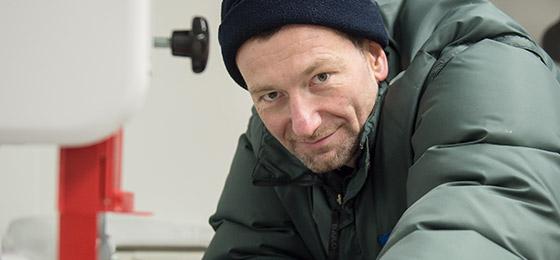Ringed by the flat horizon

The physicist Hubertus Fischer braves arctic temperatures to reconstruct past climates using ancient ice. This allows for better predictions about the climate of the future. By Daniela Kuhn
(From "Horizons" no. 106, September)
Image: © Valérie Chételat
On this radiant summer’s morning, sitting in the main campus of the University of Bern, your gaze naturally wanders to the snowcapped Alps in the distance. Just next door, in an office of the Department of Climate & Environmental Physics, the 49-year-old Hubertus Fischer explains how he became so passionate about polar exploration and climate research. When he left school, Fischer already felt drawn to the natural sciences. Nevertheless, he decided to study architecture instead. But soon missing “the stringent mathematical approach”, he began attending lectures in physics on a trial basis, and the subject fascinated him right from the outset.
The climate lies embedded in the ice
“After my intermediate examinations, I wanted to get out and taste the big, wide world”, says Fischer, laughing. So he went to study for a year at the University of Oregon, then returned to Germany and switched to Heidelberg to finish off his degree in physics. When he was hunting for a topic for his thesis in his final year, his fellow students recommended that he go to Dietmar Wagenbach. He did, and in their first conversation, Wagenbach asked: “Can you ski and cook? I might have something for you to do in Greenland”. Wagenbach went on to supervise both his undergraduate dissertation and his doctoral thesis.
Fischer didn’t need to think twice about his proposal, because he’d always loved the far north. Equipped with snowmobiles, snow groomers and tents, he and seven colleagues trekked into the interior of the world’s biggest island. The goal of their expedition was to use ice cores to reconstruct the climates of past centuries and measure the state of the air pollution in northern Greenland caused by aerosol particles from the USA and Europe.
Those weeks were an overwhelming experience, says Fischer. Nor would it be his last arctic expedition. After completing his doctorate, he first travelled to San Diego in California on a postdoc. It was there that he familiarised himself with his current special field, namely investigating gases in ice cores. Once he was back in Europe, he developed new methods for isotopic investigations of greenhouse gases in ice, first at the Alfred Wegener Institute for Polar and Marine Research in Bremerhaven, Germany, then later also at the University of Bern. These methods allowed him to quantify the sources of these gases. To get the measurements, he and his team had to drill several kilometres into the ice. The challenge was to be able to take ultra-precise measurements using the smallest possible air samples extracted from the ice. Just a few millilitres of air can offer up information about changes in the climate, the concentration of CO2 and the carbon-13 isotope content. This isotope reveals the source of the greenhouse gas – whether it comes from the ocean or from the decomposition of land bio-mass.
Experts with opinions
His results show that the concentration of CO2 is greater today than it has been for the past 800,000 years. The greenhouse gas methane is also present in higher quantities today than at any point in that same period – in recent centuries it’s risen by 150%.
“This is all a result of human activity and it’s already having a significant impact on our climate system today”. Hubertus Fischer says all this quite objectively, without any hint of outrage, and without any hint of a call to arms. But when asked about the political relevance of his research, he says, “like all climate researchers, I have my own personal stance and I’m aware of the drastic consequences of man-made climate change. But I am also able to keep my professional role as a scientist separate from my role as a citizen”. The two roles don’t contradict each other, because Hubertus Fischer’s research results are acting as a stimulus to the societal debate that’s so necessary. “At the beginning of my professional career it wasn’t my desire to save the world”, he says. “But as an expert you have to stand up and put the clear facts in front of everyone”. And that’s what he’s doing. Ever since an incident where climate sceptics misused one of his findings in order to draw illogical conclusions – namely that CO2 supposedly doesn’t have an impact on the climate – he is entirely more careful about his information superiority.